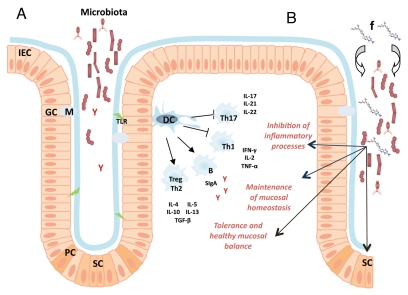Figure 1.
Schematic presentation of environmental, microbial and host interactions at the colonic mucosa. (a) The mucosa associated microbiota, the mucosal anatomy and the communicating immune system. Intestinal epithelial cells (IEC) interact with the residing microbiota through the cell surface mucous (CSM) layer, both playing essential roles in the maintenance of mucosal homeostasis.43,44 Commensal bacteria interact with intraepithelial lymphocytes,45 promote tolerogenic dendritic cells (DC) and induce the stimulation of regulatory T cells (Treg) and T helper 2 (Th2) cells.12,46 Anti-inflammatory cytokines and mediators, such as interleukin (IL) -4, -5, -10, -13 and transforming-growth-factor-β (TGFβ), are released and these molecules help maintain the healthy balance of the intestinal mucosa.47 Tolerogenic DCs also inhibit pro-inflammatory responses mediated by Th1 and Th17 cells.48 Toll-like receptor (TLR and green lightning) signaling pathways induce upregulation of antimicrobial peptides and chemoattractants, promote IEC survival (by activation of anti-apoptotic genes) and help maintain the mucosal barrier.49 Harmful bacteria are also restricted by soluble immunoglobulin-A (SIgA, red Y) produced by mucosal B cells (B).50 These mechanisms contribute to sustaining mucosal homeostasis, immunologic tolerance and prevent inflammation in a healthy organism. (B) Exogenous folate (f and also depicted by its graphic chemical structure) can act on multiple layers of the intricate network described in (A) and in the text of the manuscript. Folate can influence microbial interactions (thick arrows) and IEC regeneration through the modification of one carbon transfer mediated reactions.51 It may also impact dendritic cell responses and epithelial cell regeneration through stem cells (SC) by influencing epigenetic processes52,53 (black linear arrows).

